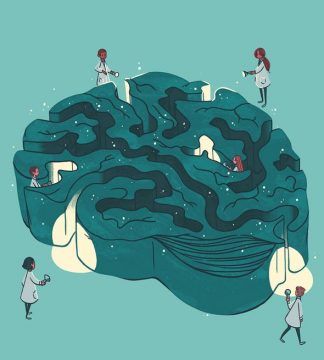Claudia Wallis in Scientific American:
 For more than 25 years one idea has dominated scientific thinking about Alzheimer’s disease: the amyloid cascade hypothesis. It holds that the disorder, which afflicts about one in 10 Americans age 65 or older, is caused by a buildup in the brain of abnormal amyloid-beta protein, which eventually destroys neurons and synapses, producing the tragic symptoms of dementia. There’s plenty of evidence for this. First, the presence of sticky clumps or “plaques” containing amyloid is a classic hallmark of the disease (along with tangles of a protein called tau). It was what Alois Alzheimer saw in the autopsied brain of patient zero in 1906. Second, families with inherited defects in amyloid precursor protein (APP) or in genes encoding proteins that process APP are plagued by early-onset Alzheimer’s. Third, mice genetically engineered to churn out excess amyloid tend to develop memory problems and do better when the amyloid pileup is stopped.
For more than 25 years one idea has dominated scientific thinking about Alzheimer’s disease: the amyloid cascade hypothesis. It holds that the disorder, which afflicts about one in 10 Americans age 65 or older, is caused by a buildup in the brain of abnormal amyloid-beta protein, which eventually destroys neurons and synapses, producing the tragic symptoms of dementia. There’s plenty of evidence for this. First, the presence of sticky clumps or “plaques” containing amyloid is a classic hallmark of the disease (along with tangles of a protein called tau). It was what Alois Alzheimer saw in the autopsied brain of patient zero in 1906. Second, families with inherited defects in amyloid precursor protein (APP) or in genes encoding proteins that process APP are plagued by early-onset Alzheimer’s. Third, mice genetically engineered to churn out excess amyloid tend to develop memory problems and do better when the amyloid pileup is stopped.
This evidence and more has led grant makers and drug companies to pour billions of dollars into amyloid-targeting therapies. More than a dozen have been tested, and one by one they have flopped. One of the biggest heartbreaks came last March, when a promising antibody to amyloid, called aducanumab, performed no better than placebo in patients with very early Alzheimer’s. Meanwhile researchers pursuing nonamyloid approaches were often left out in the cold, struggling to get grants and to have their work published. Science journalist Sharon Begley spent more than a year reporting on the lost opportunities in an article for the Web site Stat entitled “The Maddening Saga of How an Alzheimer’s ‘Cabal’ Thwarted Progress toward a Cure for Decades.” Begley notes that the amyloid crowd was “neither organized nor nefarious,” but its outsized influence stifled other avenues of investigation.
And there are so many avenues! Genetic and other evidence points to inflammation and immune dysregulation as big contributors to the disease—and likely targets for therapy.
More here.
